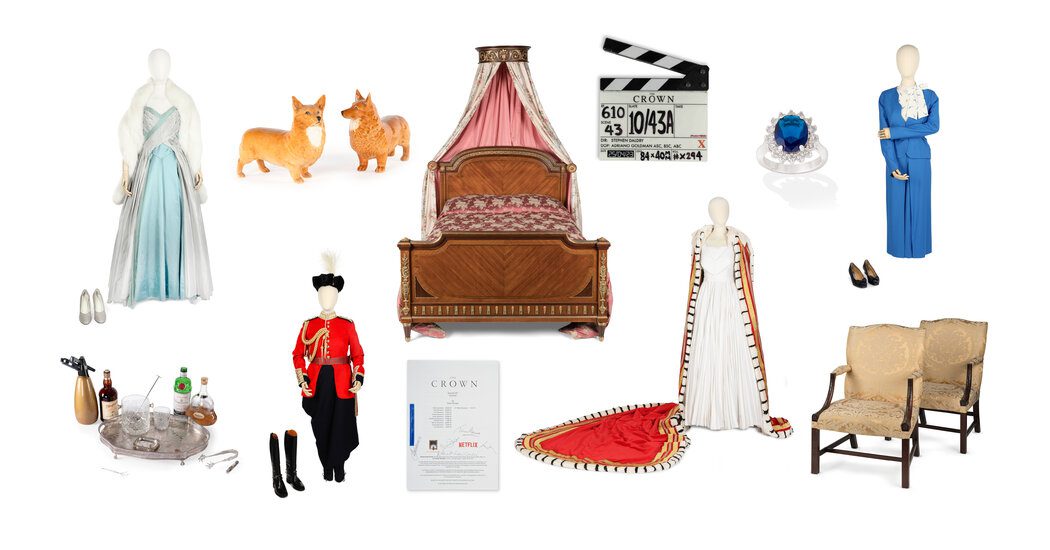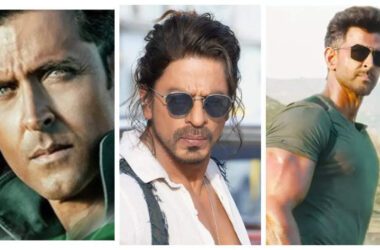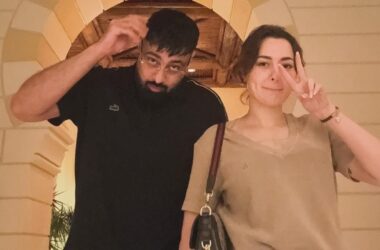[ad_1]
Despite all the scandals and tragedies, the royal lifestyle in “The Crown” looked enviably lavish.
During six seasons, Queen Elizabeth II rode around London in a golden carriage, pulled by six horses. Princess Diana gallivanted, and moped, her way across Europe in a succession of designer outfits. For special occasions, the royals donned crowns and ermine robes.
For most viewers, watching the show, which ended in December, was the closest they could get to the trappings of royal life.
Until now. Sort of.
On Feb. 7, the auction house Bonhams is scheduled to offer hundreds of items from “The Crown” in London, including intricate set pieces like a full-size replica of the golden state coach (with an estimated price of up to 50,000 pounds, or $63,000), as well as more affordable props that gave “The Crown” an air of authenticity. Those include two porcelain corgis that appeared on the queen’s writing desk ($380) and the Queen Mother’s drinks tray and champagne swizzle stick ($101).
Some items look set to be bargains — relatively speaking. One of Princess Diana’s real dresses sold last year for more than $1 million, and her “revenge dress” — the black evening gown that she wore on the evening that Prince Charles admitted, on national television, to cheating on her — once fetched $74,000. The version of the revenge dress that Elizabeth Debicki wears on “The Crown” has an estimated lot price of $10,000 to $15,000 in the Bonhams sale.
In interviews, three members of the show’s costume and set departments discussed some of the auction’s key lots. Below are edited excerpts from the conversations.
Coronation Garments
Season 1
MICHELE CLAPTON, Season 1 costume designer: The queen’s coronation was one of the big set pieces of Season 1, and it was so important to get it right. There was a lot of time spent researching the outfits, then trying to find modern fabrics that were closest to the originals, so they moved and behaved in the same way.
The robe of state, worn by Claire Foy, is red velvet and ermine, and we obviously couldn’t use ermine now, so had to find fake fur. I remember doing lots of camera tests for bits of fur, as sometimes what looked correct to the naked eye looked awful on camera.
We hand embroidered as much as we could. Sometimes, if we ran out of time, we’d do machine embroidery, or paint the fabric. For the robe, we painted some of the gold because, on TV, you wouldn’t see it. It was a really, really difficult outfit.
Ball Gown
Season 1
CLAPTON: For scenes like the coronation that were so well documented, we replicated the outfits as closely as possible. But then we had artistic license to create looks in the style of what the queen wore at the time. This ball gown was the first design I did for Claire. I remember drawing it, trying to find a way in.
We wanted to show what a film star Elizabeth was — this beauty and youth — and the lovely blue was so great with Claire’s eyes. Elizabeth would have worn things like it, but when she became queen, she instantly became more serious, and that showed in her clothes. Being frivolous and allowing herself to be free: All that was suddenly given up.
The ‘Revenge Dress’
Season 5
AMY ROBERTS, Season 3 to 6 costume designer: With certain outfits, we had to get permission from the original designer. Sometimes people said “Yes,” and sometimes “No.” With the “revenge dress,” I think the legal department couldn’t track down Christina Stambolian, the very clever Greek designer who made it, so our approach was to create our own version and give the audience what they expected to see: this marvelously sexy dress.
The dress, which Elizabeth Debicki wore, said so much about the strength of Diana, and that’s what we were aiming for.
There were other moments we had to speak with the legal department. With the dress Kate Middleton wore at the university fashion show, the original designer didn’t want that copied, and I remember sending photographs of fittings to the lawyers for them to approve: “Yes, that’s different enough,” or, “No, you need to change it a bit more.”
ROBERTS: With the military uniforms, that was all about total accuracy. This one was for Trooping the Color, a ceremony that marks the monarch’s official birthday. The medals, the ribbons: All those details had to be forensically accurate, otherwise it’d be embarrassing and not nice to people who served. We had a whole military department, headed by Max Birkett, and I’d just turn up and say, “Yes, great color, this is perfect!” So it was all down to them.
All the queens were amazing to design for. There were very few arguments. I always say my biggest arguments were with Dominic West, who played Prince Charles. We’d argue each morning as to what tie and pocket square combinations we were going to have. He’d go, “Oh, this is boring,” and I’d have to go, “No, it’s marvelous!”
Model of the Queen’s Funeral Procession
Season 6
ALISON HARVEY, set decorator: The queen (Imelda Staunton) inspecting a model of her own funeral procession was Stephen Daldry’s idea, the final episode’s director, so I bought all the lead soldiers I could find from auction sites and eBay until my whole desk was covered in them. Then Stephen said, “No, I want an exact copy of the queen’s funeral” and many of the regiments weren’t available, so we had to make a lot of figures from scratch ourselves, scanning real people in costumes, then miniaturizing the outfits, 3D-printing out our own models, hand painting them. We even had to get our replica crown jewels in, so we could make a tiny crown to go on the tiny coffin with a tiny flag.
It was about three months’ work, in various stages.
Gold State Coach
Seasons 3 and 6
HARVEY: We talked about using C.G.I. for the golden coach, but then everyone decided they wanted to see it for real, so there was about three months of discussion about how on earth we were going to do it. We went to the Royal Mews, at Buckingham Palace, to look at the real one and took photos of it, like any other tourists, then tried to do our own as authentically as we could. The Devil’s Horsemen, the company who supplied our horses, had a chassis, and our model makers adapted it, sculpting in clay these amazing rococo-style palm leaves, then casting them and gilding them, and making all the other decoration.
It was a mountain of work. I think it cost us £85,000 and about 25 people worked on it, using all these traditional skills. We even had to think about engineering: How to get this thing to move around. It was really wobbly!
The Queen’s Bed
Seasons 1-6
HARVEY: With every set, we’d look at photographs, videos, go through books, through the Royal Collection website — anything that could hold a nugget of information about what the royals were like to give layers of believability.
Obviously, I don’t know what the queen’s bed was like, but we know that King George IV, who was king from 1820 to 1830, collected a lot of French furniture, so this antique, in the style of a bed from Louis XVI’s time, is a best guess.
We’d always try to buy real antiques first, rather than making something from scratch. I’d spend a lot of time in auction houses, or buying items from country house sales, trying to find the real thing.
The Queen’s Chairs
Seasons 1-6
HARVEY: If you look at the royal collection online, there’s a lot of Georgian furniture, and these chairs are in the style of a classic armchair from that period. On the show, the queen uses these when hosting prime ministers at weekly meetings. We got an amazing woodcarver to make them from scratch, then we found a tiny sample of this gold fabric and a damask we liked and sent it to a company in Italy, who dyed fabric to match and wove the bespoke material in an 18th-century mill. It sounds like a lot of effort, but we were fortunate to have a long run-in time.
I’ve no idea who’ll buy them, but they’re a nice set with great provenance if you’ve got a big enough sitting room. Every famous actor’s bottom has sat on them.
Source link









